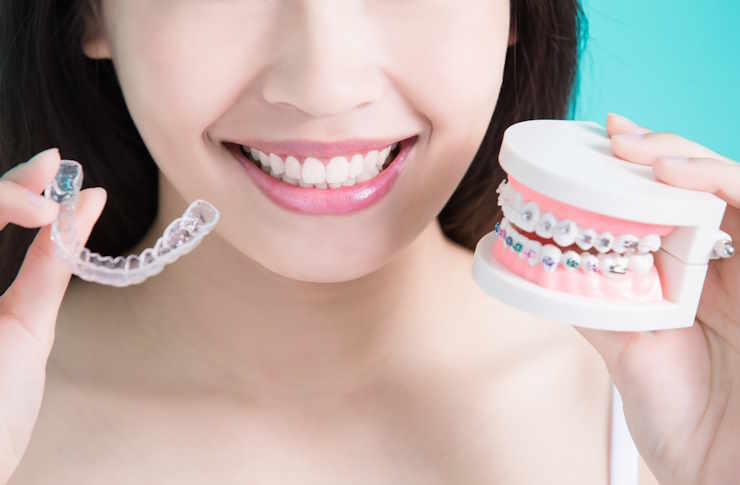New Technology for Smiling: Why Are More and More People Choosing Invisible Braces?
More and more adults and teenagers are quietly changing their smiles—not with traditional metal braces, but with nearly invisible braces. If you’re also looking for a way to straighten your teeth without affecting your daily life, invisible braces may be the right choice for you.

How do invisible braces work?
Invisible braces, also known as clear aligners, use a series of custom-made, transparent plastic trays to gradually shift teeth into their desired positions. These aligners are designed based on 3D scans or impressions of your teeth. Each set of aligners is worn for about two weeks before moving on to the next set in the series. The aligners apply gentle, consistent pressure to move teeth incrementally, typically requiring 20 to 30 sets for a complete treatment.
What makes invisible braces different from traditional braces?
Unlike traditional metal braces, invisible aligners are removable and nearly undetectable when worn. This key difference allows users to eat, drink, brush, and floss without the restrictions often associated with metal braces. The absence of wires and brackets also means fewer orthodontic appointments and reduced risk of mouth irritation. Invisible braces offer a more comfortable and flexible orthodontic experience, making them particularly appealing to adults and image-conscious teenagers.
Who is a good candidate for invisible braces?
Invisible braces are suitable for many people with mild to moderate orthodontic issues. They can effectively treat problems such as crowded teeth, gaps between teeth, and some bite issues. However, they may not be ideal for severe cases of misalignment or complex bite problems. A consultation with an orthodontist or dentist specializing in clear aligners can determine if you’re a good candidate. Generally, invisible braces work best for adults and responsible teenagers who can commit to wearing the aligners for 20-22 hours per day.
What are the advantages of choosing invisible braces?
The primary advantage of invisible braces is their aesthetics. They allow people to straighten their teeth without the self-consciousness often associated with metal braces. Additionally, the removable nature of the aligners makes maintaining oral hygiene much easier. Users can brush and floss normally, reducing the risk of decay and gum problems during treatment. The smooth plastic material of the aligners also tends to be more comfortable than traditional braces, causing less irritation to the cheeks and gums.
Are there any challenges or limitations with invisible braces?
While invisible braces offer many benefits, they do come with some challenges. The success of the treatment heavily depends on patient compliance. Since the aligners are removable, there’s a temptation to leave them out for longer than recommended, which can slow down progress. Some people may experience a slight lisp when first wearing the aligners, though this usually subsides quickly. Additionally, invisible braces may not be suitable for all orthodontic cases, particularly those requiring significant tooth rotation or vertical movement.
How much do invisible braces cost?
The cost of invisible braces can vary significantly depending on the complexity of the case, the brand chosen, and the duration of treatment. Generally, invisible braces tend to be more expensive than traditional metal braces. Here’s a comparison of some popular invisible braces providers:
| Provider | Average Cost Range | Treatment Duration | Key Features |
|---|---|---|---|
| Invisalign | $3,000 - $8,000 | 12-18 months | In-office treatment, suitable for complex cases |
| SmileDirectClub | $1,950 - $2,386 | 4-6 months | At-home impression kits, remote monitoring |
| Candid | $2,400 - $3,300 | 6-11 months | Hybrid model with in-person initial consultation |
| Byte | $1,895 - $2,295 | 3-6 months | HyperByte technology for faster treatment |
Prices, rates, or cost estimates mentioned in this article are based on the latest available information but may change over time. Independent research is advised before making financial decisions.
In conclusion, invisible braces offer a modern solution for those seeking to improve their smile without the conspicuous appearance of traditional braces. Their convenience, comfort, and aesthetic appeal have made them an increasingly popular choice among adults and teenagers alike. While they may not be suitable for everyone, the technology behind invisible braces continues to advance, making them a viable option for a growing number of orthodontic cases. As with any dental treatment, it’s essential to consult with a qualified orthodontist to determine the best approach for your specific needs and to ensure the best possible outcome for your smile.
This article is for informational purposes only and should not be considered medical advice. Please consult a qualified healthcare professional for personalized guidance and treatment.




